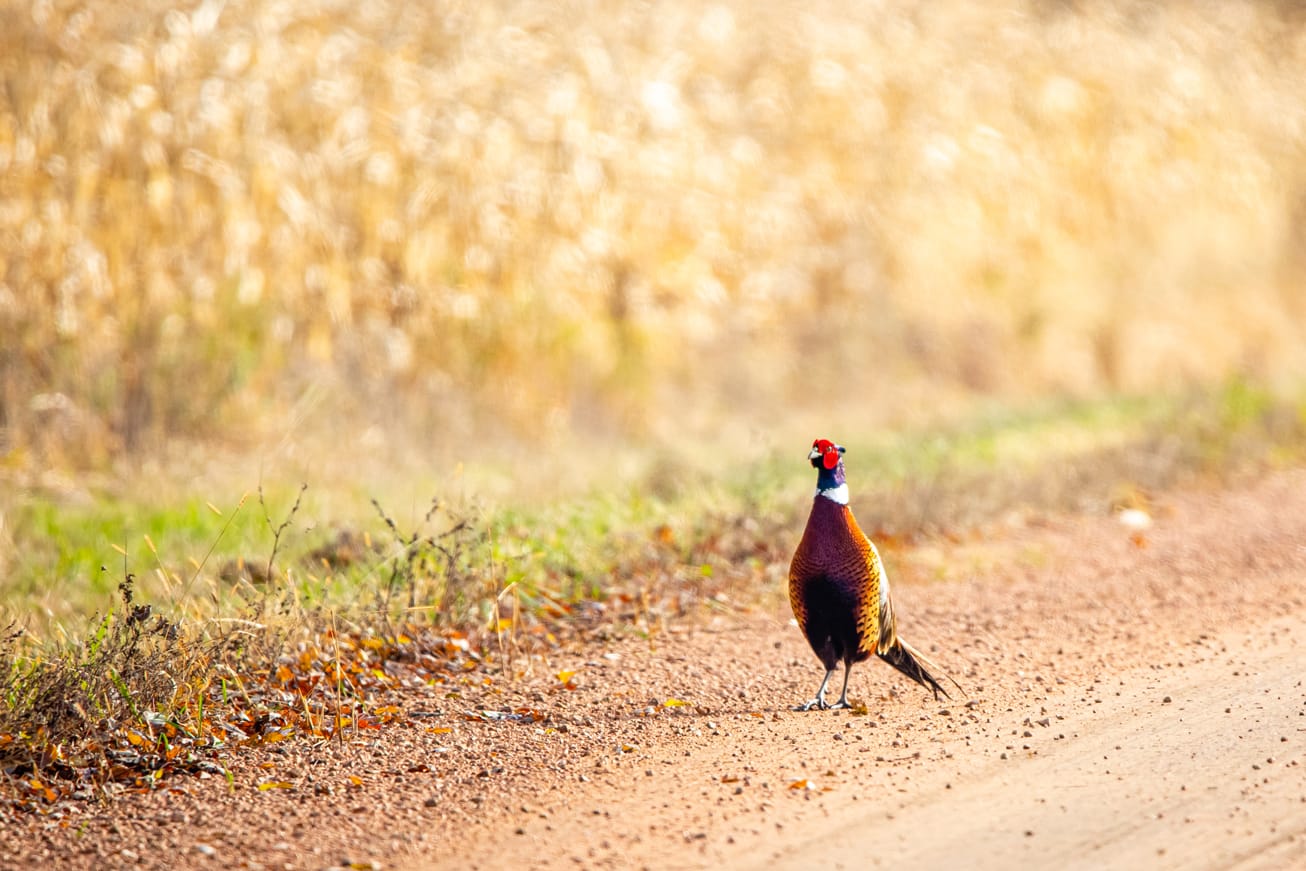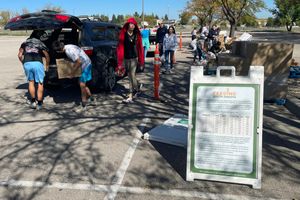No neighboring state is as liberal as South Dakota when it comes to traveling with loaded guns and hunting on, along or over roads.
Despite accidents in which hunters have been killed or wounded, it remains legal for a hunter to drive with a loaded, uncased firearm along almost any highway or road except an interstate.
The hunter can pull over, exit the vehicle and then fire at pheasants, waterfowl or other small game from the pavement or the ditch – even at a bird flying across the travel lanes.
Hunters cannot fire within 660 feet of any church, school, occupied dwelling or livestock. With few exceptions – special permits granted to handicapped hunters or people trying to kill predators such as coyotes — hunters are not allowed to shoot from the vehicle.
Even though driving with a loaded gun while on the hunt is legal, some law enforcement officers and hunter safety teachers say it is dangerous.

“It’s kind of been a strong issue with me, that it may be legal but it’s not smart,” said Ron Kolbeck of Salem, who has taught state HuntSAFE programs for more than 20 years. “I try to address what is the safest way and not just what’s legal.”
Numerous hunters have been injured in South Dakota while road hunting or while carrying a loaded gun in a vehicle, according to state records.
From 2003 to 2013, 29 vehicle-related incidents leading to four deaths were reported. From 2015 to 2018, officials documented 10 incidents involving road hunting or gun transport.
In addition to a couple close calls where family members had guns discharged in a vehicle, a co-worker of Kolbeck’s lost her husband to a hunting accident in South Dakota in 2008 when a loaded gun went off in a vehicle, killing him.
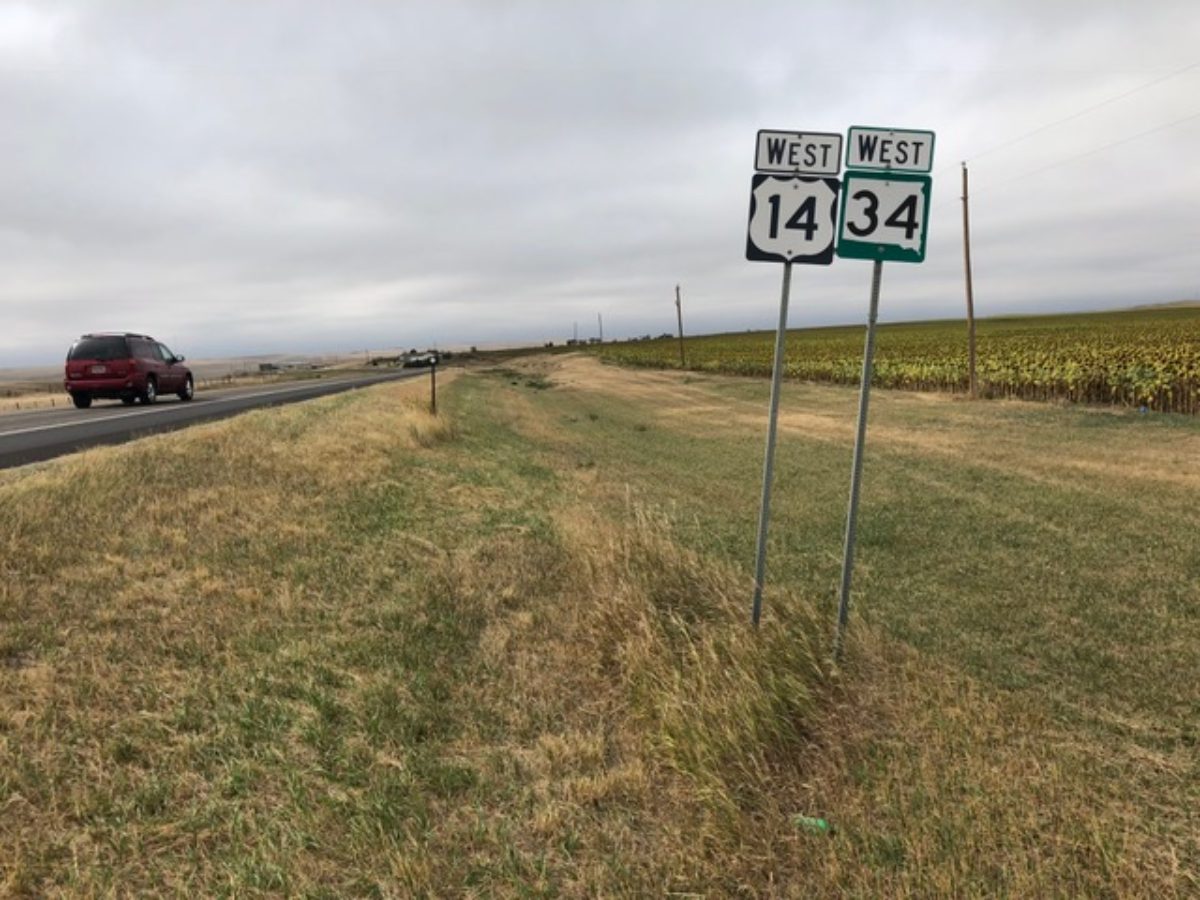
Road hunting a South Dakota tradition
Laws allowing hunting in the rights-of-way, or the land under and alongside a highway or road, are part of a longstanding hunting tradition in South Dakota.
The main target of so-called road hunting in South Dakota is the state’s famous pheasant population. The birds drew nearly 128,000 hunters in 2022, about 58% from other states. Hunters harvested more than 1.1 million birds during the pheasant hunting season that started in mid-October and ended Jan. 31.
Many hunters view road hunting as safe if done properly and see it as a way for people who don’t have access to private land to hunt in areas where target animals congregate.
Road hunting also makes hunting much easier because it doesn’t require a bird dog, a large hunting party or long walks through a field. Game animals can be readily seen and pursued.
“There are people who have no place to hunt, and that’s where they are going to hunt, and we’re totally fine with it,” said Rory Ehlers, operator of the Dakota Prairie Hunting reserve near Midland.
“Sometimes when you’re an individual, it’s hard to walk 100 acres by yourself, or they could be older, so road hunting is the only option they have.”
Not all hunters supportive of laws
But road hunting is unpopular among some members of the state’s pheasant preserve hunting industry.
At a Game, Fish & Parks Department listening session in 2018, some preserve owners complained that road hunters routinely break safety rules and laws and put their guests in danger by exiting vehicles in a state of “pheasant fever.”
“We’ve had several near-misses and one of our guests was shot in the head by road hunters,” one session attendee wrote. “We have also witnessed road hunters shooting out of windows.”
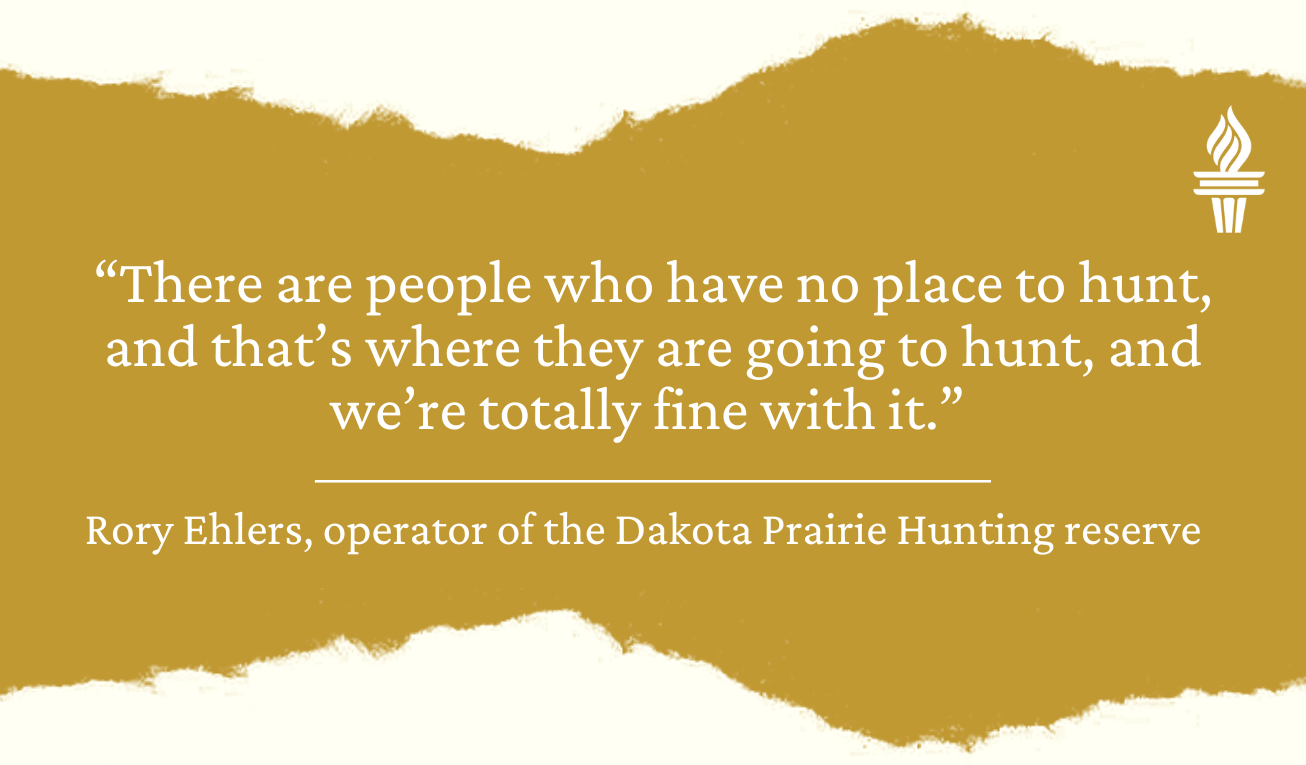
Animals must be in the right-of-way or flying over it before they can legally be hunted from the roads and ditches. Hunters are allowed to retrieve birds that are shot and fall onto private property as long as they do not bring their gun during the retrieval.
But Ehlers and others say road hunters under the influence of adrenaline sometimes “push the laws to the limit” in order to take a bird.
“When the only place a person can find a bird is next to a preserve, it leads to a lot of hunting illegally because they are not road hunting ‘the right way,’” one GFP session attendee commented. “When the preserve owner confronts the road hunter, it either leads to a chase or a confrontation because all hunters feel it is their right to road hunt and very few know the laws.”
Statistics illustrate the dangers of road hunting
Hunting carries inherent risks that, according to hunter safety teachers, can be minimized through a combination of following all laws, using common sense and engaging in practices that limit exposure to harm.
Each year, several South Dakota hunters are injured or killed while in the field, according to Patrick Klotzbach, who has worked as a HuntSAFE Coordinator for the GFP.
From 1988 to 2018, the state recorded 920 hunting incidents involving injury or death in all hunting situations. During that period, 34 deaths mostly from firearm incidents occurred, though heart attacks and drownings while hunting are also included in that number.
The vast majority of injuries occur during pheasant hunts when hunters are struck by pellets from shotgun shells fired by others in their party who swing the gun to follow a flying bird or who shoot unknowingly into other hunters ahead of them in a field.
But road hunting factors into many of the incidents:
- A hunter was shot while driving from one hunting spot to another with a loaded gun in Gregory County in October 2015.
- A passenger with his arm out the window of a passing truck was struck by pellets from a road hunter firing from a ditch in Hanson County in November 2016.
- A hunter shot himself in the foot while exiting a vehicle to shoot at a pheasant in a ditch in Hutchinson County in December 2016.
- And a man shot himself with a rifle while entering his truck in Lyman County in November 2017.
Klotzbach said he and other hunter safety trainers stress that guns should be unloaded around or in the vehicle even if it is legal.
“I always stress safety, even if it’s not against the law,” he said. “Usually it’s carelessness, or buck fever or pheasant fever becomes a factor.”
In South Dakota, a road hunter who puts another person in danger or fear of serious physical harm is guilty of a Class 1 misdemeanor, which carries a maximum penalty of a $1,000 fine.
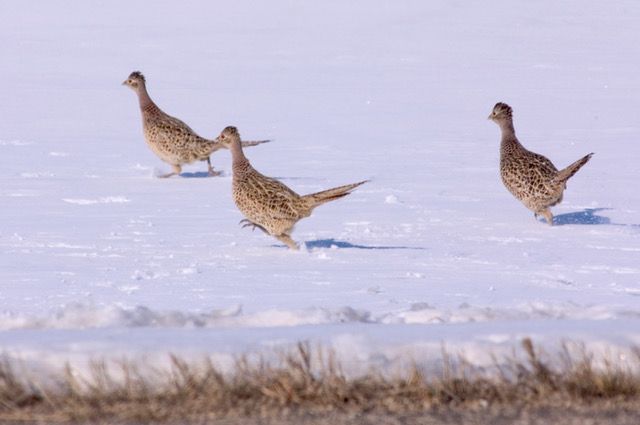
South Dakota laws most permissive of road hunting
The laws in states surrounding South Dakota differ widely, though no other state allows both loaded guns in vehicles and road hunting in the right-of-way.
Of neighboring states, North Dakota hunting laws are the closest to those in South Dakota.
Road hunting is legal on public rights-of-ways in North Dakota, though most roadside ditches and fields are privately owned in the state. It is the hunter’s responsibility to know whether land is private. A gun can be uncased in vehicles in North Dakota but cannot have a bullet in the chamber.
In Iowa, shooting a rifle on or over public highways is illegal. Guns must be unloaded and cased in a vehicle, except as permitted by law.
In Nebraska, shotguns must be unloaded but can be uncased in a vehicle, while rifles can be loaded and uncased. Hunting from the road or in rights-of-ways is illegal in the Cornhusker State.
In Minnesota, it is legal to road hunt for small game on public roads, but guns must be unloaded at all times in a vehicle, though they can be uncased.
Montana does not prohibit hunters from carrying weapons in their vehicles, according to the Montana Department of Justice. However, it is illegal to hunt on, from or across any public roadway unless the individual has a certified disability and a permit to hunt from a vehicle.
Mike Lee, who spent a decade as a game warden in the field, said that the law against road hunting doesn’t always stop the practice. He recalled a mishap a few years ago when a hunter pulled over to shoot at a grouse and shot out the window of an oncoming semi.
“This is one of our more common violations in Montana,” he said. “There’s definitely public safety concerns with people hunting off a public roadway.”
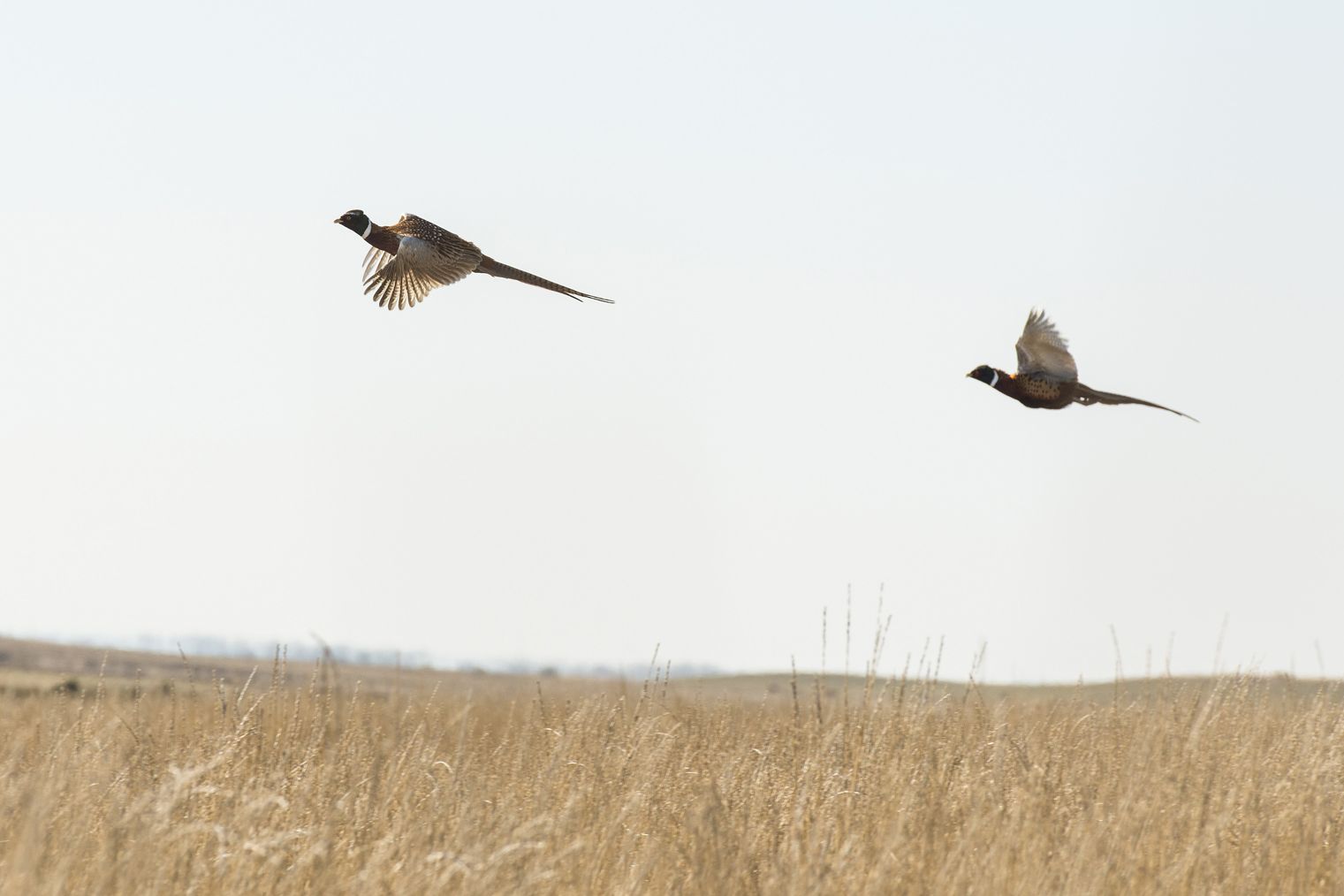
Road hunting can be dangerous even when done legally
The danger in driving with a loaded, uncased firearm is that there is almost no safe way to ensure the muzzle of the gun is pointed in a safe direction, one of the most basic tenets of any hunting safety course, Kolbeck said.
The risk in hunting from the roadway, shoulders or ditches is that hunters must not only ensure the safety of themselves and others in their hunting party but also drivers of vehicles or motorcycles that are passing by on the road, said Andy Alban, who has worked as a law enforcement administrator for the South Dakota GFP.
“You could shoot across the road, but I don’t typically personally do that,” Alban said. “Obviously, there’s another safety concern in play there since you’ve got to be aware of oncoming traffic.”
The vexing part of road hunting is that even when done legally, it can be dangerous to the hunter and unsuspecting people nearby, said Dave Olsen, owner of Pheasant Phun hunting preserve near the Beadle County town of Hitchcock.
Olsen said he has sometimes guided a group of clients on a hunt when a road hunter has pulled up nearby and shot without looking out for hunters in his party.
“Somebody who is completely law-abiding, a bird flies out toward my hunting party and he shoots,” Olsen said. “A lot of people lose all common sense over a 6-pound bird.”
Olsen said he supports road hunting as a practice but would like to see the 660-foot safety zone expanded to include roads along hunting preserves.
Barely surviving a road-hunting accident
A case of buck fever and disregard for basic safety rules nearly cost Lon Reidburn of Clark his legs – and his life.
Reidburn was road hunting with a neighbor on Nov. 22, 1982, when they saw some deer and pulled over to get a shot.
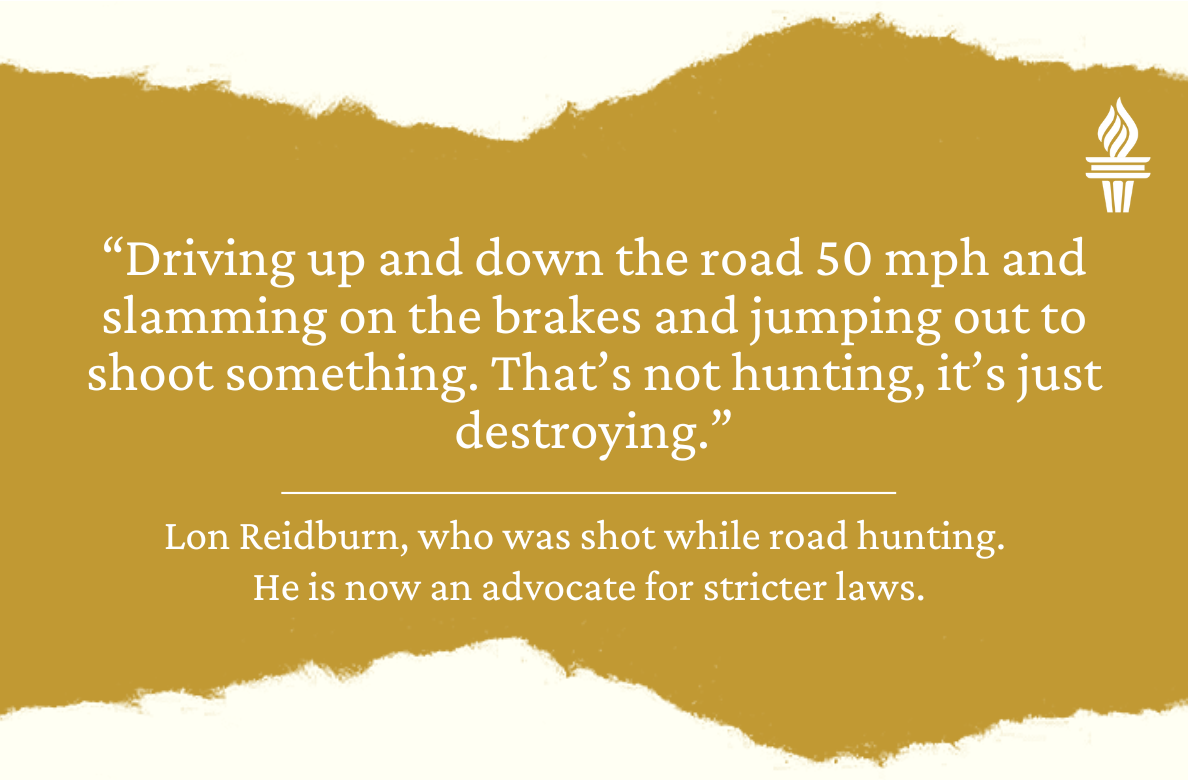
As his friend moved across the front seat past the steering while holding his loaded rifle, it went off and the bullet struck Reidburn, who was standing outside the truck. The bullet shattered both his femurs and left him unable to move and bleeding profusely.
Soon after, Reidburn and his wife were told by doctors at a hospital in Watertown to “expect the worst” and that he was likely to lose his right leg. After a flight to Sioux Falls, a doctor saved both his legs, but Reidburn spent a year at home, out of work and needing constant care during recovery.
‘That’s not hunting, it’s just destroying’
Reidburn rarely hunts now, and never for deer. He has become an advocate for stricter gun transport and road hunting laws in South Dakota and was featured in a video in 2014 as part of the state GFP safety promotional effort called “Get Outta the Truck.”
Reidburn, who had to give up his career as a carpenter in favor of selling insurance after the accident, said he is greeted with empathy when he meets with lawmakers but has yet to see a legislator make a formal proposal to stiffen hunting safety laws.
With a mix of anger over lax laws, disappointment in himself for hunting so carelessly, and sadness over the year he lost and frequent leg pain he endures, Reidburn continues to call for action against carrying loaded guns in vehicles and hunting from state roadways.
“Why would you carry something loaded in your vehicle? What does it teach the kids when you do that?” Reidburn asked.
Reidburn said he still sees hunters take needless risks. He recalls seeing a road hunter jump from a truck to shoot at a pheasant as his unattended vehicle drove itself into a ditch.
“Driving up and down the road 50 mph and slamming on the brakes and jumping out to shoot something. That’s not hunting, it’s just destroying,” Reidburn said. “It’s just wrong, wrong. There’s just so many things that can go wrong there, why would you want to do that? They should put a stop to it now.”

